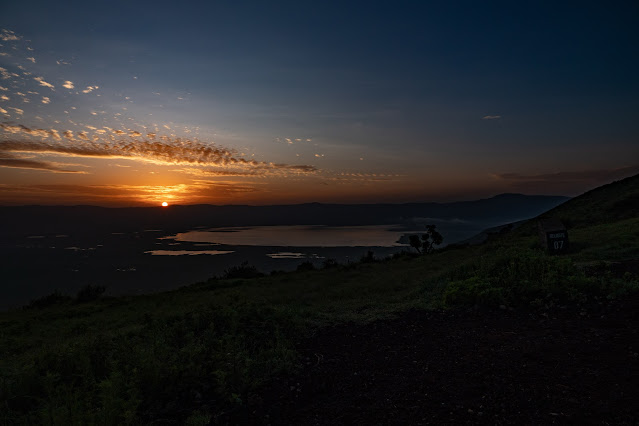Finishing the Tanzania Safari today, so we can move on to a couple of amazing hikes.
So far we have Arusha, Tarangire National Park, South Serengeti Part 1, South Serengeti Part 2, and the rest of the Serengeti tour. Today we move on to Ngorogoro Crater, the world's largest caldera* and an area dense with wildlife, including the endangered black rhino (spoiler alert: we only saw these from such a distance that the photos are useless, as you shall see).
With the goal of seeing sunrise from the crater rim, we were up and out very early. Our first distraction was the well-chewed carcass of a cape buffalo which something had dragged into the road during the night. Despite that and other excitements, we made it to the perfect viewpoint at just the right time.
After all the dirt roads, it was a bit odd to find the road down into the caldera (it's generally called Ngorogoro Crater, but is in fact a caldera**) paved, even with paving stones. It's really too steep to be left as dirt!
As soon as we neared the bottom, we began seeing herds of Cape Buffalo, wildebeest, and zebras.
 |
The road to the bottom.
|
I'll just present a selection of critters we saw as we cruised the caldera floor:
 |
Dang, I love these stripey ponies!
|
 |
| Spoonbill |
 |
Elephant with cattle egret hitching a ride--and looking for bugs.
|
 |
Eland--the largest species of antelope.
|
 |
A pair of crested cranes. They mate for life and stay together all the time. We saw some with chicks, always too deep in the grass for a good photo.
|
 |
| Warthogs. We saw far more of them here than anywhere else, and they were more willing to stand still and pose. |
|
 |
Cape Buffalo also posed well here, with egrets and flamingos.
|
 |
Greater and lesser flamingos flocked the shores of the shallow lake. Pretty sure these are Greater Flamingos, larger and less pink, but with those striking wings.
|
 |
Finally caught a hippo posing on land!
|
 |
| Hyena |
 |
Guinea fowl, a.k.a. yummy kuku (chicken). We may have been eating one while photographing this one.
|
After lunch we drove out of the caldera to begin the long drive back to Arusha.
 |
View from the rim.
|
And, just to prove we saw them, if you squint hard at this photo you can see it's a rhino. We were so far away that not only was it too far for my 600 mm telephoto, but atmospheric distortion meant no one was getting a good photo. What we could tell was that those critters are BIG. Note the tiny-looking impala in the foreground, and the safari truck beyond.
Back to our haven at the Arusha Planet Lodge for one night, before heading to Mt. Meru--stay tuned for sunrises from on high!
 |
So much good food. Breakfasts like this are one reason this wasn't a trip on which to lose weight!
|
*Only true if a few qualifiers are added to exclude the Yellowstone caldera. Unlike Yellowstone, the Ngorogoro Caldera is in one piece and easily visible as a caldera, though huge. Unlike some others (see: Crater Lake) it has only a few small lakes on the bottom rather than being completely full of water. Kind of makes you wonder where the water goes.
**A crater is a depression at the top of a volcano formed by blowing out the rocks (it can also be the hole left after something large falls on the ground, as in a meteotite crater). A caldera is formed when the roof of a magma chamber collapses, and is much larger than a crater. Nice explanation here with illustrations for those who want it.
©Rebecca M. Douglass, 2024
As always, please ask permission to use any
photos or text. Link-backs appreciated.
Don't miss a post--Follow us!

















I’m enjoying your trip tremendously, but reading everything in emails. Your photos are fabulous. The rhino is amazing. And the striped ponies look very healthy!
ReplyDelete